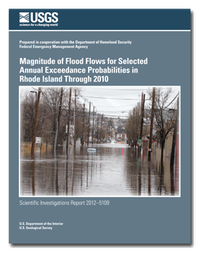Magnitude of flood flows for selected annual exceedance probabilities in Rhode Island through 2010
Links
- More information: USGS Index Page (html)
- Download citation as: RIS | Dublin Core
Abstract
Heavy persistent rains from late February through March 2010 caused severe widespread flooding in Rhode Island that set or nearly set record flows and water levels at many long-term streamgages in the State. In response, the U.S. Geological Survey, in partnership with the Federal Emergency Management Agency, conducted a study to update estimates of flood magnitudes at streamgages and regional equations for estimating flood flows at ungaged locations. This report provides information needed for flood plain management, transportation infrastructure design, flood insurance studies, and other purposes that can help minimize future flood damages and risks. The magnitudes of floods were determined from the annual peak flows at 43 streamgages in Rhode Island (20 sites), Connecticut (14 sites), and Massachusetts (9 sites) using the standard Bulletin 17B log-Pearson type III method and a modification of this method called the expected moments algorithm (EMA) for 20-, 10-, 4-, 2-, 1-, 0.5-, and 0.2-percent annual exceedance probability (AEP) floods. Annual-peak flows were analyzed for the period of record through the 2010 water year; however, records were extended at 23 streamgages using the maintenance of variance extension (MOVE) procedure to best represent the longest period possible for determining the generalized skew and flood magnitudes. Generalized least square regression equations were developed from the flood quantiles computed at 41 streamgages (2 streamgages in Rhode Island with reported flood quantiles were not used in the regional regression because of regulation or redundancy) and their respective basin characteristics to estimate magnitude of floods at ungaged sites. Of 55 basin characteristics evaluated as potential explanatory variables, 3 were statistically significant—drainage area, stream density, and basin storage. The pseudo-coefficient of determination (pseudo-R2) indicates these three explanatory variables explain 95 to 96 percent of the variance in the flood magnitudes from 20- to 0.2-percent AEPs. Estimates of uncertainty of the at-site and regression flood magnitudes are provided and were combined with their respective estimated flood quantiles to improve estimates of flood flows at streamgages. This region has a long history of urban development, which is considered to have an important effect on flood flows. This study includes basins that have an impervious area ranging from 0.5 to 37 percent. Although imperviousness provided some explanatory power in the regression, it was not statistically significant at the 95-percent confidence level for any of the AEPs examined. Influence of urbanization on flood flows indicates a complex interaction with other characteristics that confounds a statistical explanation of its effects. Standard methods for calculating magnitude of floods for given AEP are based on the assumption of stationarity, that is, the annual peak flows exhibit no significant trend over time. A subset of 16 streamgages with 70 or more years of unregulated systematic record indicates all but 4 streamgages have a statistically significant positive trend at the 95-percent confidence level; three of these are statistically significant at about the 90-percent confidence level or above. If the trend continues linearly in time, the estimated magnitude of floods for any AEP, on average, will increase by 6, 13, and 21 percent in 10, 20, and 30 years' time, respectively. In 2010, new peaks of record were set at 18 of the 21 active streamgages in Rhode Island. The updated flood frequency analysis indicates the peaks at these streamgages ranged from 2- to 0.2-percent AEP. Many streamgages in the State peaked at a 0.5- and 0.2-percent AEP, except for streamgages in the Blackstone River Basin, which peaked from a 4- to 2-percent AEP.
Study Area
| Publication type | Report |
|---|---|
| Publication Subtype | USGS Numbered Series |
| Title | Magnitude of flood flows for selected annual exceedance probabilities in Rhode Island through 2010 |
| Series title | Scientific Investigations Report |
| Series number | 2012-5109 |
| DOI | 10.3133/sir20125109 |
| Year Published | 2012 |
| Language | English |
| Publisher | U.S. Geological Survey |
| Publisher location | Reston, VA |
| Contributing office(s) | Massachusetts-Rhode Island Water Science Center |
| Description | vii [vii], 48 p.; Glossary: pgs. 49-50; Tables 7, 13, and 15: pgs. 51-76; Appendices: pgs. 77-81; XLS Download of Appendix 3 |
| First page | i |
| Last page | 81 |
| Time Range Start | 2010-02-15 |
| Time Range End | 2010-03-31 |
| Country | United States |
| State | Rhode Island |
| Online Only (Y/N) | N |
| Additional Online Files (Y/N) | Y |


